华为广告的多模态隐喻研究
- 格式:docx
- 大小:39.70 KB
- 文档页数:17
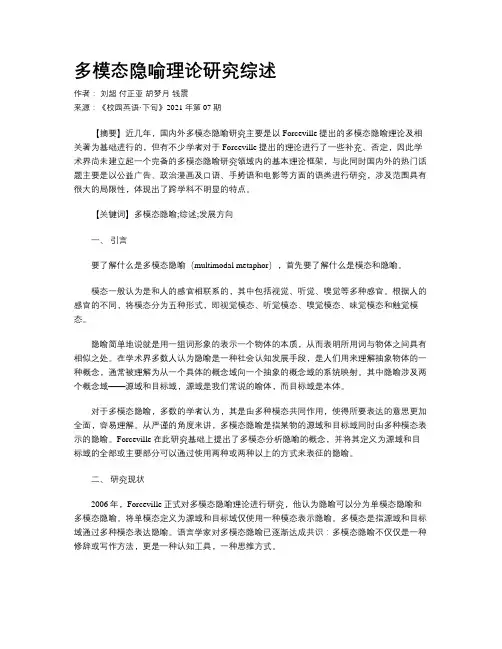
多模态隐喻理论研究综述作者:刘超付正亚胡梦月钱震来源:《校园英语·下旬》2021年第07期【摘要】近几年,国内外多模态隐喻研究主要是以Forceville提出的多模态隐喻理论及相关著为基础进行的,但有不少学者对于Forceville提出的理论进行了一些补充、否定,因此学术界尚未建立起一个完备的多模态隐喻研究领域内的基本理论框架,与此同时国内外的热门话题主要是以公益广告、政治漫画及口语、手势语和电影等方面的语类进行研究,涉及范围具有很大的局限性,体现出了跨学科不明显的特点。
【关键词】多模态隐喻;综述;发展方向一、引言要了解什么是多模态隐喻(multimodal metaphor),首先要了解什么是模态和隐喻。
模态一般认为是和人的感官相联系的,其中包括视觉、听觉、嗅觉等多种感官。
根据人的感官的不同,将模态分为五种形式,即视觉模态、听觉模态、嗅觉模态、味觉模态和触觉模态。
隐喻简单地说就是用一组词形象的表示一个物体的本质,从而表明所用词与物体之间具有相似之处。
在学术界多数人认为隐喻是一种社会认知发展手段,是人们用来理解抽象物体的一种概念,通常被理解为从一个具体的概念域向一个抽象的概念域的系统映射。
其中隐喻涉及两个概念域——源域和目标域,源域是我们常说的喻体,而目标域是本体。
对于多模态隐喻,多数的学者认为,其是由多种模态共同作用,使得所要表达的意思更加全面,容易理解。
从严谨的角度来讲,多模态隐喻是指某物的源域和目标域同时由多种模态表示的隐喻。
Forceville在此研究基础上提出了多模态分析隐喻的概念,并将其定义为源域和目标域的全部或主要部分可以通过使用两种或两种以上的方式来表征的隐喻。
二、研究现状2006年,Forceville正式对多模态隐喻理论进行研究,他认为隐喻可以分为单模态隐喻和多模态隐喻。
将单模态定义为源域和目标域仅使用一种模态表示隐喻。
多模态是指源域和目标域通过多种模态表达隐喻。
语言学家对多模态隐喻已逐渐达成共识:多模态隐喻不仅仅是一种修辞或写作方法,更是一种认知工具,一种思维方式。
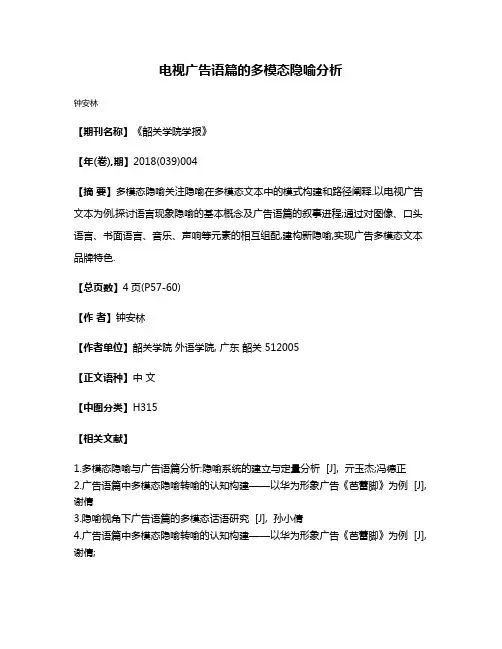
电视广告语篇的多模态隐喻分析
钟安林
【期刊名称】《韶关学院学报》
【年(卷),期】2018(039)004
【摘要】多模态隐喻关注隐喻在多模态文本中的模式构建和路径阐释.以电视广告文本为例,探讨语言现象隐喻的基本概念及广告语篇的叙事进程;通过对图像、口头语言、书面语言、音乐、声响等元素的相互组配,建构新隐喻,实现广告多模态文本品牌特色.
【总页数】4页(P57-60)
【作者】钟安林
【作者单位】韶关学院外语学院, 广东韶关 512005
【正文语种】中文
【中图分类】H315
【相关文献】
1.多模态隐喻与广告语篇分析:隐喻系统的建立与定量分析 [J], 亓玉杰;冯德正
2.广告语篇中多模态隐喻转喻的认知构建——以华为形象广告《芭蕾脚》为例 [J], 谢倩
3.隐喻视角下广告语篇的多模态话语研究 [J], 孙小倩
4.广告语篇中多模态隐喻转喻的认知构建——以华为形象广告《芭蕾脚》为例 [J], 谢倩;
5.英国电视公益广告态度意义多模态认知评价分析——以交通安全类电视公益广告语篇为例 [J], 毛现桩
因版权原因,仅展示原文概要,查看原文内容请购买。
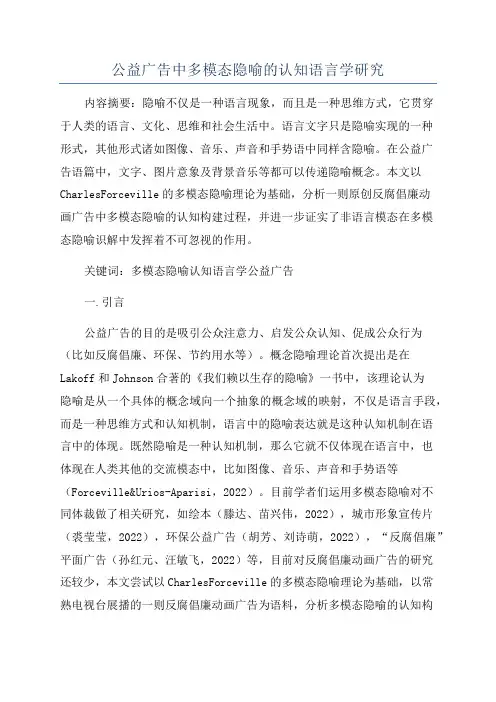
公益广告中多模态隐喻的认知语言学研究内容摘要:隐喻不仅是一种语言现象,而且是一种思维方式,它贯穿于人类的语言、文化、思维和社会生活中。
语言文字只是隐喻实现的一种形式,其他形式诸如图像、音乐、声音和手势语中同样含隐喻。
在公益广告语篇中,文字、图片意象及背景音乐等都可以传递隐喻概念。
本文以CharlesForceville的多模态隐喻理论为基础,分析一则原创反腐倡廉动画广告中多模态隐喻的认知构建过程,并进一步证实了非语言模态在多模态隐喻识解中发挥着不可忽视的作用。
关键词:多模态隐喻认知语言学公益广告一.引言公益广告的目的是吸引公众注意力、启发公众认知、促成公众行为(比如反腐倡廉、环保、节约用水等)。
概念隐喻理论首次提出是在Lakoff和Johnson合著的《我们赖以生存的隐喻》一书中,该理论认为隐喻是从一个具体的概念域向一个抽象的概念域的映射,不仅是语言手段,而是一种思维方式和认知机制,语言中的隐喻表达就是这种认知机制在语言中的体现。
既然隐喻是一种认知机制,那么它就不仅体现在语言中,也体现在人类其他的交流模态中,比如图像、音乐、声音和手势语等(Forceville&Urios-Aparisi,2022)。
目前学者们运用多模态隐喻对不同体裁做了相关研究,如绘本(滕达、苗兴伟,2022),城市形象宣传片(裘莹莹,2022),环保公益广告(胡芳、刘诗萌,2022),“反腐倡廉”平面广告(孙红元、汪敏飞,2022)等,目前对反腐倡廉动画广告的研究还较少,本文尝试以CharlesForceville的多模态隐喻理论为基础,以常熟电视台展播的一则反腐倡廉动画广告为语料,分析多模态隐喻的认知构建,并进一步证实了非语言模态在多模态隐喻识解中发挥着不可忽视的作用。
二.多模态隐喻研究三.反腐倡廉动画广告的多模态隐喻分析该反腐倡廉广告采用动画形式,时长1分25秒,以一条小鱼从小贪到大贪,最后被绳之于法的发展顺序展开,通过语言、色彩、图像和声音等模态共同作用,诠释了“常思贪欲之害,常怀律己之心”这一主题。
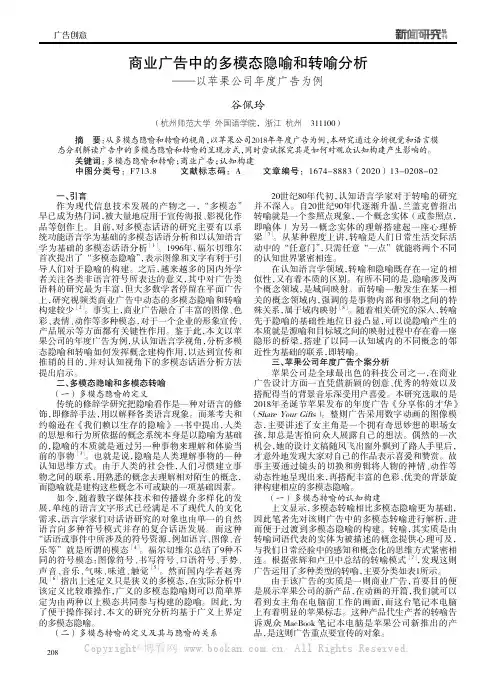
208广告创意商业广告中的多模态隐喻和转喻分析——以苹果公司年度广告为例谷佩玲(杭州师范大学 外国语学院,浙江 杭州 311100)摘 要:从多模态隐喻和转喻的视角,以苹果公司2018年年度广告为例,本研究通过分析视觉和语言模态分别解读广告中的多模态隐喻和转喻的呈现方式,同时尝试探究其是如何对观众认知构建产生影响的。
关键词:多模态隐喻和转喻;商业广告;认知构建中图分类号:F713.8 文献标志码:A 文章编号:1674-8883(2020)13-0208-02一、引言作为现代信息技术发展的产物之一,“多模态”早已成为热门词,被大量地应用于宣传海报、影视化作品等创作上。
目前,对多模态话语的研究主要有以系统功能语言学为基础的多模态话语分析和以认知语言学为基础的多模态话语分析[1]。
1996年,福尔切维尔首次提出了“多模态隐喻”,表示图像和文字有利于引导人们对于隐喻的构建。
之后,越来越多的国内外学者关注各类非语言符号所表达的意义,其中对广告类语料的研究最为丰富,但大多数学者停留在平面广告上,研究视频类商业广告中动态的多模态隐喻和转喻构建较少[2]。
事实上,商业广告融合了丰富的图像、色彩、表情、动作等多种模态,对于一个企业的形象宣传、产品展示等方面都有关键性作用。
鉴于此,本文以苹果公司的年度广告为例,从认知语言学视角,分析多模态隐喻和转喻如何发挥概念建构作用,以达到宣传和推销的目的,并对认知视角下的多模态话语分析方法提出启示。
二、多模态隐喻和多模态转喻(一)多模态隐喻的定义传统的修辞学研究把隐喻看作是一种对语言的修饰,即修辞手法,用以解释各类语言现象。
而莱考夫和约翰逊在《我们赖以生存的隐喻》一书中提出,人类的思想和行为所依据的概念系统本身是以隐喻为基础的,隐喻的本质就是通过另一种事物来理解和体验当前的事物[3]。
也就是说,隐喻是人类理解事物的一种认知思维方式。
由于人类的社会性,人们习惯建立事物之间的联系,用熟悉的概念去理解相对陌生的概念,而隐喻就是建构这些概念不可或缺的一项基础因素。
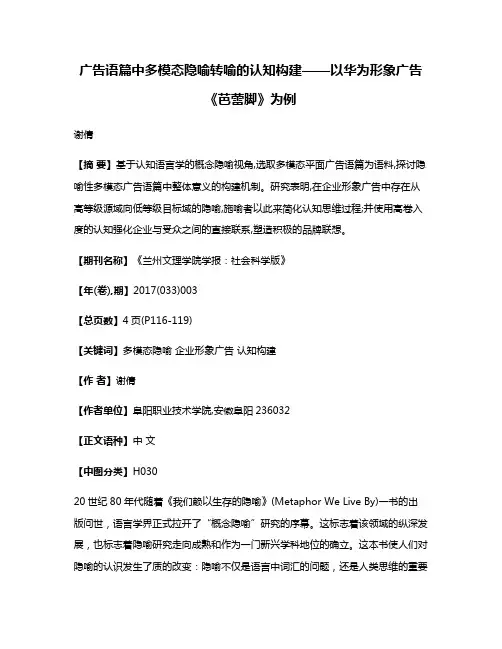
广告语篇中多模态隐喻转喻的认知构建——以华为形象广告《芭蕾脚》为例谢倩【摘要】基于认知语言学的概念隐喻视角,选取多模态平面广告语篇为语料,探讨隐喻性多模态广告语篇中整体意义的构建机制。
研究表明,在企业形象广告中存在从高等级源域向低等级目标域的隐喻,施喻者以此来简化认知思维过程;并使用高卷入度的认知强化企业与受众之间的直接联系,塑造积极的品牌联想。
【期刊名称】《兰州文理学院学报:社会科学版》【年(卷),期】2017(033)003【总页数】4页(P116-119)【关键词】多模态隐喻企业形象广告认知构建【作者】谢倩【作者单位】阜阳职业技术学院,安徽阜阳236032【正文语种】中文【中图分类】H03020世纪80年代随着《我们赖以生存的隐喻》(Metaphor We Live By)一书的出版问世,语言学界正式拉开了“概念隐喻”研究的序幕。
这标志着该领域的纵深发展,也标志着隐喻研究走向成熟和作为一门新兴学科地位的确立。
这本书使人们对隐喻的认识发生了质的改变:隐喻不仅是语言中词汇的问题,还是人类思维的重要手段,直接参与人类的认知过程,其“实质是通过另一类事物来理解和经历某一类事物”[1]。
如今多媒体数字信息化时代的到来使得语篇呈现多模态化,更以其独特优势有力的推动了隐喻研究的发展。
这种学科间的相互借鉴催生了新的研究方向,以Forceville为代表的国外学者将概念隐喻研究延伸到了更为广阔的符号交际范畴,独树一帜地提出了多模态隐喻理论,大大拓展了隐喻的研究视野,开创了新的研究视角和研究领域。
此后,多模态隐喻在语言学界得到广泛重视和研究,国内外许多学者纷纷撰文发表自己有关该领域的最新成果。
这些研究大多以广告、漫画等语料,围绕多模态隐喻语类的区别性特征、多模态隐喻相似性表征方式等焦点展开研究。
而对一种全新广告形式——企业形象广告涉及到的多模态隐转喻研究尚待进一步开掘。
企业形象广告是“以树立企业的形象和信誉为诉求目的”[2]。
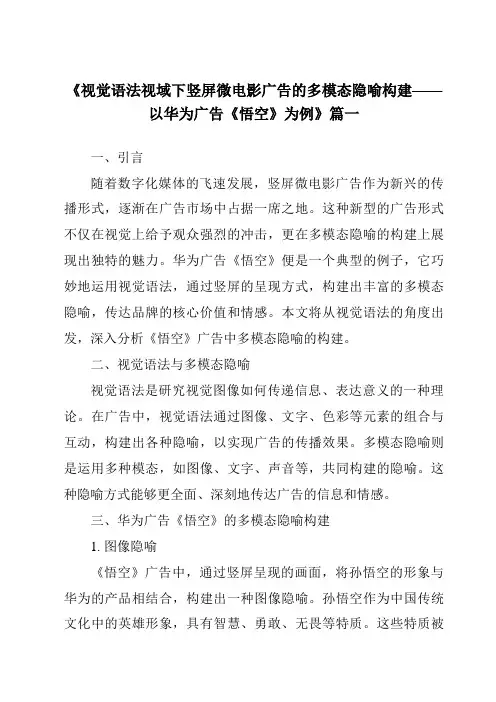
《视觉语法视域下竖屏微电影广告的多模态隐喻构建——以华为广告《悟空》为例》篇一一、引言随着数字化媒体的飞速发展,竖屏微电影广告作为新兴的传播形式,逐渐在广告市场中占据一席之地。
这种新型的广告形式不仅在视觉上给予观众强烈的冲击,更在多模态隐喻的构建上展现出独特的魅力。
华为广告《悟空》便是一个典型的例子,它巧妙地运用视觉语法,通过竖屏的呈现方式,构建出丰富的多模态隐喻,传达品牌的核心价值和情感。
本文将从视觉语法的角度出发,深入分析《悟空》广告中多模态隐喻的构建。
二、视觉语法与多模态隐喻视觉语法是研究视觉图像如何传递信息、表达意义的一种理论。
在广告中,视觉语法通过图像、文字、色彩等元素的组合与互动,构建出各种隐喻,以实现广告的传播效果。
多模态隐喻则是运用多种模态,如图像、文字、声音等,共同构建的隐喻。
这种隐喻方式能够更全面、深刻地传达广告的信息和情感。
三、华为广告《悟空》的多模态隐喻构建1. 图像隐喻《悟空》广告中,通过竖屏呈现的画面,将孙悟空的形象与华为的产品相结合,构建出一种图像隐喻。
孙悟空作为中国传统文化中的英雄形象,具有智慧、勇敢、无畏等特质。
这些特质被巧妙地转移到华为产品上,传达出华为产品的高科技、创新、可靠的品牌形象。
2. 色彩隐喻在色彩运用上,《悟空》广告也展现了高超的技巧。
广告中大量运用了金色、红色等鲜艳的色彩,这些色彩不仅与中华文化的审美相契合,更传达出一种高贵、尊贵的品牌氛围。
同时,这些色彩也被用作构建隐喻的元素,如金色的科技界面象征着华为产品的先进性。
3. 文字隐喻除了图像和色彩,《悟空》广告中的文字也承担着构建隐喻的任务。
广告中的文字不仅传递了产品的基本信息,更通过双关、隐喻等修辞手法,传达出品牌的情感和价值观。
例如,“一触即发”这样的文字既表达了产品的操作简单,又隐喻了产品的强大性能。
四、《悟空》广告多模态隐喻的效果通过上述多模态隐喻的构建,《悟空》广告成功地传达了华为品牌的形象和价值观。
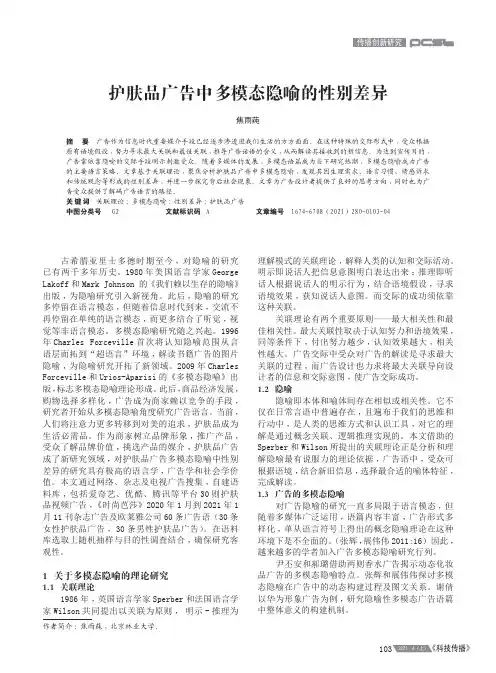
《科技传播》103作者简介:焦雨莼,北京林业大学。
护肤品广告中多模态隐喻的性别差异焦雨莼摘 要 广告作为信息时代重要媒介手段已经逐步渗透进我们生活的方方面面。
在这种特殊的交际形式中,受众根据原有语境假设,努力寻求最大关联和最佳关联,推导广告话语的含义,从而解读其接收到的新信息。
为达到宣传目的,广告常依靠隐喻的交际手段明示刺激受众。
随着多媒体的发展,多模态语篇成为当下研究热潮,多模态隐喻成为广告的主要语言策略。
文章基于关联理论,聚焦分析护肤品广告中多模态隐喻,发现其因生理需求、语言习惯、情感诉求和传统观念等形成的性别差异,并进一步探究背后社会现象。
文章为广告设计者提供了良好的思考方向,同时也为广告受众提供了解码广告语言的路径。
关键词 关联理论;多模态隐喻;性别差异;护肤品广告中图分类号 G2 文献标识码 A 文章编号 1674-6708(2021)280-0103-04古希腊亚里士多德时期至今,对隐喻的研究已有两千多年历史。
1980年美国语言学家George Lakoff 和Mark Johnson 的《我们赖以生存的隐喻》出版,为隐喻研究引入新视角。
此后,隐喻的研究多停留在语言模态,但随着信息时代到来,交流不再停留在单纯的语言模态,而更多结合了听觉,视觉等非语言模态。
多模态隐喻研究随之兴起。
1996年Charles Forceville 首次将认知隐喻范围从言语层面拓到“超语言”环境,解读书籍广告的图片隐喻,为隐喻研究开拓了新领域。
2009年Charles Forceville 和Urios-Aparisi 的《多模态隐喻》出版,标志多模态隐喻理论形成。
此后,商品经济发展,购物选择多样化,广告成为商家赖以竞争的手段,研究者开始从多模态隐喻角度研究广告语言。
当前,人们将注意力更多转移到对美的追求,护肤品成为生活必需品。
作为商家树立品牌形象,推广产品,受众了解品牌价值,挑选产品的媒介,护肤品广告成了新研究领域,对护肤品广告多模态隐喻中性别差异的研究具有极高的语言学,广告学和社会学价值。
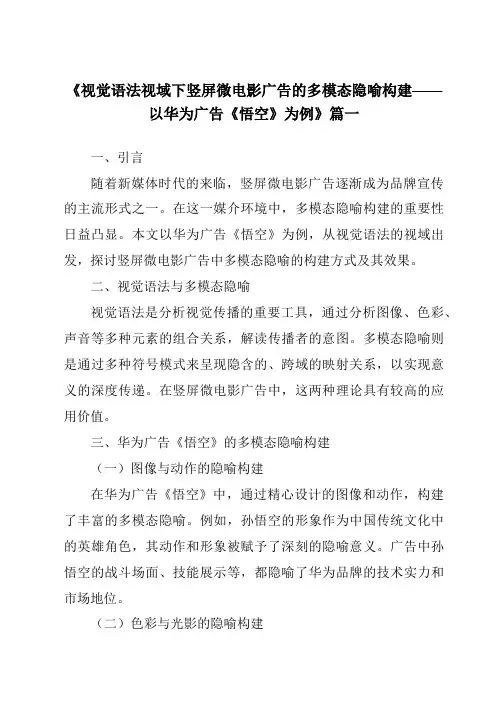
《视觉语法视域下竖屏微电影广告的多模态隐喻构建——以华为广告《悟空》为例》篇一一、引言随着新媒体时代的来临,竖屏微电影广告逐渐成为品牌宣传的主流形式之一。
在这一媒介环境中,多模态隐喻构建的重要性日益凸显。
本文以华为广告《悟空》为例,从视觉语法的视域出发,探讨竖屏微电影广告中多模态隐喻的构建方式及其效果。
二、视觉语法与多模态隐喻视觉语法是分析视觉传播的重要工具,通过分析图像、色彩、声音等多种元素的组合关系,解读传播者的意图。
多模态隐喻则是通过多种符号模式来呈现隐含的、跨域的映射关系,以实现意义的深度传递。
在竖屏微电影广告中,这两种理论具有较高的应用价值。
三、华为广告《悟空》的多模态隐喻构建(一)图像与动作的隐喻构建在华为广告《悟空》中,通过精心设计的图像和动作,构建了丰富的多模态隐喻。
例如,孙悟空的形象作为中国传统文化中的英雄角色,其动作和形象被赋予了深刻的隐喻意义。
广告中孙悟空的战斗场面、技能展示等,都隐喻了华为品牌的技术实力和市场地位。
(二)色彩与光影的隐喻构建色彩和光影是竖屏微电影广告中重要的视觉元素。
在《悟空》中,通过运用明亮的色彩和强烈的对比,营造出强烈的视觉冲击力。
同时,光影的变化也隐喻了故事情节的发展和人物情感的转变,使得广告更具感染力。
(三)声音与配乐的隐喻构建声音和配乐在竖屏微电影广告中起着至关重要的作用。
在《悟空》中,背景音乐激昂有力,与画面中的动作和情感相得益彰。
同时,广告中的对话和音效也起到了强化故事情节和人物形象的作用,进一步构建了多模态隐喻。
四、多模态隐喻的效果分析华为广告《悟空》通过多模态隐喻的构建,成功地将品牌信息与故事情节、人物形象等元素融合在一起,实现了意义的深度传递。
这种多模态隐喻的构建方式不仅提高了广告的观赏性,也增强了观众对品牌的认知和记忆。
同时,这种隐喻式的表达方式也使得品牌信息更具感染力和说服力,有助于提升品牌的形象和价值。
五、结论本文从视觉语法的视域出发,分析了竖屏微电影广告中多模态隐喻的构建方式及其效果。
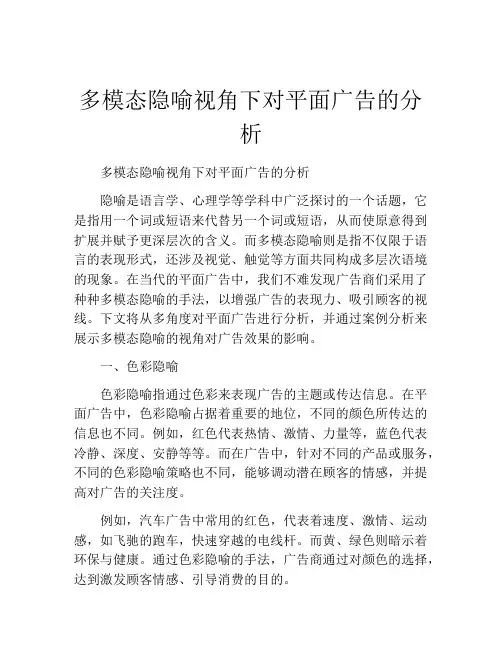
多模态隐喻视角下对平面广告的分析多模态隐喻视角下对平面广告的分析隐喻是语言学、心理学等学科中广泛探讨的一个话题,它是指用一个词或短语来代替另一个词或短语,从而使原意得到扩展并赋予更深层次的含义。
而多模态隐喻则是指不仅限于语言的表现形式,还涉及视觉、触觉等方面共同构成多层次语境的现象。
在当代的平面广告中,我们不难发现广告商们采用了种种多模态隐喻的手法,以增强广告的表现力、吸引顾客的视线。
下文将从多角度对平面广告进行分析,并通过案例分析来展示多模态隐喻的视角对广告效果的影响。
一、色彩隐喻色彩隐喻指通过色彩来表现广告的主题或传达信息。
在平面广告中,色彩隐喻占据着重要的地位,不同的颜色所传达的信息也不同。
例如,红色代表热情、激情、力量等,蓝色代表冷静、深度、安静等等。
而在广告中,针对不同的产品或服务,不同的色彩隐喻策略也不同,能够调动潜在顾客的情感,并提高对广告的关注度。
例如,汽车广告中常用的红色,代表着速度、激情、运动感,如飞驰的跑车,快速穿越的电线杆。
而黄、绿色则暗示着环保与健康。
通过色彩隐喻的手法,广告商通过对颜色的选择,达到激发顾客情感、引导消费的目的。
二、图像隐喻图像隐喻是指通过图像来表达广告的主题、传递信息、调动消费者的情感。
平面广告的设计中,图像隐喻是最直观的手法,能够迅速引起顾客的关注,在有限的空间内传达更多信息。
例如:奥迪汽车广告,凭借着她硕大凶猛的狮头,迅速引起了顾客的注意,并激发了消费欲望,而狮子隐喻的是豪华、权威这些奥迪汽车所代表的特质,这种精准的图像隐喻也是广告的成功之处。
三、符号隐喻符号隐喻是指通过符号来表达广告意义的一种手法。
符号可以是文字、数字、简单的线条或形状,也可以是物品、人物,等等。
符号隐喻是从微观的角度出发,揭示广告的细节和内在意义。
例如:百事可乐的广告就使用了“玻璃瓶”这一符号,表现出百事可乐的纯正、自然和健康的品牌形象。
在另一个例子中,麦当劳的快餐广告则使用了“女孩”这一符号,直接暗示了顾客对于麦当劳食品的喜好和选择。
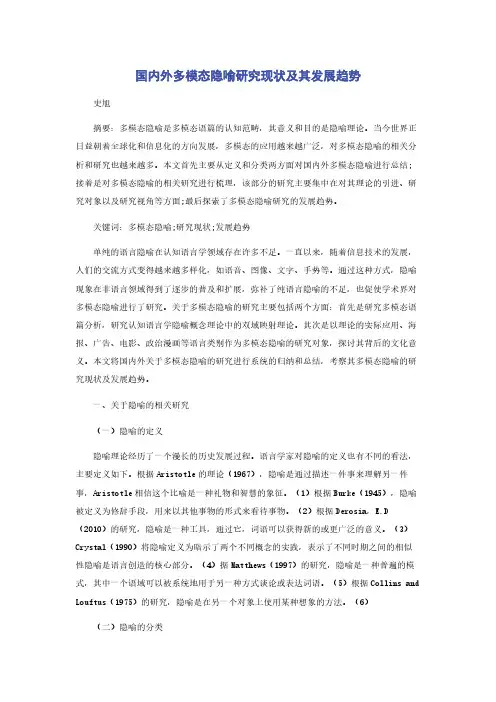
国内外多模态隐喻研究现状及其发展趋势史旭摘要:多模态隐喻是多模态语篇的认知范畴,其意义和目的是隐喻理论。
当今世界正日益朝着全球化和信息化的方向发展,多模态的应用越来越广泛,对多模态隐喻的相关分析和研究也越来越多。
本文首先主要从定义和分类两方面对国内外多模态隐喻进行总结;接着是对多模态隐喻的相关研究进行梳理,该部分的研究主要集中在对其理论的引进、研究对象以及研究视角等方面;最后探索了多模态隐喻研究的发展趋势。
关键词:多模态隐喻;研究现状;发展趋势单纯的语言隐喻在认知语言学领域存在许多不足。
一直以来,随着信息技术的发展,人们的交流方式变得越来越多样化,如语音、图像、文字、手势等。
通过这种方式,隐喻现象在非语言领域得到了逐步的普及和扩展,弥补了纯语言隐喻的不足,也促使学术界对多模态隐喻进行了研究。
关于多模态隐喻的研究主要包括两个方面:首先是研究多模态语篇分析,研究认知语言学隐喻概念理论中的双域映射理论。
其次是以理论的实际应用、海报、广告、电影、政治漫画等语言类别作为多模态隐喻的研究对象,探讨其背后的文化意义。
本文将国内外关于多模态隐喻的研究进行系统的归纳和总结,考察其多模态隐喻的研究现状及发展趋势。
一、关于隐喻的相关研究(一)隐喻的定义隐喻理论经历了一个漫长的历史发展过程。
语言学家对隐喻的定义也有不同的看法,主要定义如下。
根据Aristotle的理论(1967),隐喻是通过描述一件事来理解另一件事,Aristotle相信这个比喻是一种礼物和智慧的象征。
(1)根据Burke(1945),隐喻被定义为修辞手段,用来以其他事物的形式来看待事物。
(2)根据Derosia,E.D (2010)的研究,隐喻是一种工具,通过它,词语可以获得新的或更广泛的意义。
(3)Crystal(1990)将隐喻定义为暗示了两个不同概念的实践,表示了不同时期之间的相似性隐喻是语言创造的核心部分。
(4)据Matthews(1997)的研究,隐喻是一种普遍的模式,其中一个语域可以被系统地用于另一种方式谈论或表达词语。
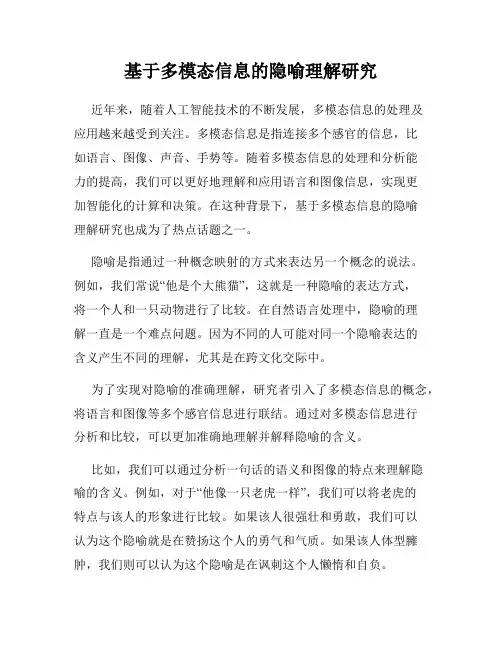
基于多模态信息的隐喻理解研究近年来,随着人工智能技术的不断发展,多模态信息的处理及应用越来越受到关注。
多模态信息是指连接多个感官的信息,比如语言、图像、声音、手势等。
随着多模态信息的处理和分析能力的提高,我们可以更好地理解和应用语言和图像信息,实现更加智能化的计算和决策。
在这种背景下,基于多模态信息的隐喻理解研究也成为了热点话题之一。
隐喻是指通过一种概念映射的方式来表达另一个概念的说法。
例如,我们常说“他是个大熊猫”,这就是一种隐喻的表达方式,将一个人和一只动物进行了比较。
在自然语言处理中,隐喻的理解一直是一个难点问题。
因为不同的人可能对同一个隐喻表达的含义产生不同的理解,尤其是在跨文化交际中。
为了实现对隐喻的准确理解,研究者引入了多模态信息的概念,将语言和图像等多个感官信息进行联结。
通过对多模态信息进行分析和比较,可以更加准确地理解并解释隐喻的含义。
比如,我们可以通过分析一句话的语义和图像的特点来理解隐喻的含义。
例如,对于“他像一只老虎一样”,我们可以将老虎的特点与该人的形象进行比较。
如果该人很强壮和勇敢,我们可以认为这个隐喻就是在赞扬这个人的勇气和气质。
如果该人体型臃肿,我们则可以认为这个隐喻是在讽刺这个人懒惰和自负。
因此,基于多模态信息的隐喻理解可以在很大程度上帮助人们更加准确地理解和解读语言信息。
在文学、广告、翻译等领域应用广泛。
比如,在翻译领域中,很多隐喻表达方式在不同语言之间的表达差异非常大。
基于多模态信息的隐喻理解则可以更加准确地将这些表达方式进行转化和翻译,提高翻译的精准度和效率。
不过,基于多模态信息的隐喻理解也存在一些挑战和限制。
首先,不同感官信息之间的连接和比较需要大量的计算资源和数据支持。
其次,多模态信息的处理和分析需要考虑到不同人的文化背景和认知方式的差异,这也是一个极具挑战性的任务。
总之,基于多模态信息的隐喻理解是一个需要探索和研究的新领域。
尽管还存在一些挑战和限制,但随着技术的不断发展和应用的不断拓展,基于多模态信息的隐喻理解将会成为一个非常重要的研究方向,对科技发展和人类社会进步都将产生重要的影响。
公益广告中隐喻的多模态研究隐喻作为思维的一种方式,不仅存在于语言之中而且存在于思想和行动之中。
语言只是隐喻实现的一种形式,其他领域诸如绘画、音乐、电影和广告中也存在隐喻。
广告中的隐喻已成为众多专家、学者研究的热门话题。
然后,大部分的相关研究停留在文字模态层面或图像模态层面的隐喻,很少对多模态层面的隐喻展开探索。
公益广告是维护社会道德、提升社会意识的教育力量,同时也是利用模态间的相互联系进行隐喻研究的最佳范例。
基于概念隐喻理论和多模态隐喻理论,本文采用描写、阐释、内省和数据库分析等研究方法,对公益广告中的隐喻进行多模态研究。
本文旨在回答以下四方面的问题: (1)公益广告中隐喻的工作机制是什么?(2)从多模态的角度,隐喻在公益广告中是如何呈现的?(3)隐喻在公益广告中发挥了怎样的作用?(4)是否存在影响公益广告中隐喻构建的因素?如果存在,因素有哪些?本文的主要研究结果可归纳如下: (1)立足于概念隐喻理论和多模态隐喻理论,公益广告中隐喻的工作机制存在两种类型。
就单模态隐喻而言,在隐喻映射的帮助下,目标域意义的理解与始源域的经验及特征息息相关;就多模态隐喻而言,始源义借助图像/语言工具得以表示,同时它也作为思维工具来获取目标义。
(2)根据公益广告中不同模态的相互作用,隐喻的呈现方式分为文字呈现、图像呈现及多模态呈现。
随着现代网络技术和多媒体技术的发展,公益广告中隐喻的多模态化日渐盛行,隐喻的呈现方式也更倾向于多模态。
(3)通过数据库分析研究,公益广告中隐喻的功能分为信息功能、启发功能和美学功能。
(4)公益广告中隐喻的识解受客观因素和主管因素的影响。
客观因素指具体某个广告的语境和文化特征,主观因素指目标观众的百科知识和个人经验。
(5)在对公益广告中隐喻进行多模态分析,进一步证明隐喻和转喻是密切联系的。
转喻的指示和突显功能有助于隐喻的构建,隐喻的识解扩大了转喻的映射范围。
笔者希望,本文能为将来的隐喻研究带来一定的启示,同时也能促进公益广告中隐喻的创造及隐喻意义的识解。
国内多模态隐喻研究热点及前沿趋势1. 国内多模态隐喻研究概述随着我国语言学研究的不断深入和发展,多模态隐喻研究逐渐成为国内学术界的热点。
多模态隐喻作为一种独特的语言现象,涉及词汇、语法、语义等多个层面,对于理解人类思维方式和文化背景具有重要意义。
在国内多模态隐喻研究中,学者们关注的主要研究方向包括:多模态隐喻的定义、分类与特征;多模态隐喻在不同领域和语境中的应用;多模态隐喻的生成机制和认知过程等。
国内学者还关注多模态隐喻与其他相关领域的交叉研究,如跨文化交际、社会认知、心理语言学等。
为了更好地推动我国多模态隐喻研究的发展,学者们积极参与国内外学术交流与合作,不断提高自身的研究水平。
国内高校和科研机构也纷纷设立了专门的多模态隐喻研究课程和实验室,为研究生提供了良好的学习和研究环境。
在政策层面,国家和地方政府也对多模态隐喻研究给予了大力支持,通过资助项目、举办学术会议等方式,推动该领域的研究进展。
我国多模态隐喻研究已经取得了一定的成果,但仍存在一些亟待解决的问题。
如何进一步拓展多模态隐喻的研究范畴,使其能够更好地适应不同领域和语境的需求;如何揭示多模态隐喻生成过程中的认知机制和规律,以及如何将多模态隐喻与其他相关领域的研究成果进行有效整合等。
在未来的研究中,我国学者将继续努力,以期在这一领域取得更多的突破和进展。
1.1 多模态隐喻的定义与特点多模态隐喻是指在语言表达中,通过将一个概念或对象与另一个具有不同模态(如视觉、听觉等)的概念或对象进行类比,从而产生新的语义关系和意义。
多模态隐喻的研究涉及到多个学科领域,如认知心理学、语言学、计算机科学等。
随着大数据和人工智能技术的发展,多模态隐喻研究逐渐成为国内外学术界的热点。
多样性:多模态隐喻可以涵盖多种模态,如视觉、听觉、触觉等,以及多种类型,如物体隐喻、行为隐喻等。
这使得多模态隐喻具有丰富的内涵和表达形式。
动态性:多模态隐喻并非固定不变的,而是可以根据上下文和语境的变化而发生变化。
多模态隐喻的构建与分类系统功能视角一、本文概述本文旨在探讨多模态隐喻的构建与分类,并从系统功能的视角进行深入分析。
多模态隐喻是一种重要的语言现象,它不仅仅局限于传统的文字表达,而是融合了语言、图像、声音等多种模态,使得隐喻的表达更加丰富和多样。
在现代社会,随着多媒体技术的快速发展,多模态隐喻在广告、影视、社交媒体等领域的应用越来越广泛,因此对其构建与分类的研究具有重要的理论和实践价值。
本文将首先回顾隐喻理论的发展历程,从传统的单一模态隐喻到多模态隐喻的转变,阐述多模态隐喻在语言学研究中的重要地位。
接着,我们将深入探讨多模态隐喻的构建过程,包括不同模态之间的相互作用和协同工作,以及多模态隐喻意义的生成机制。
我们还将从系统功能的视角出发,对多模态隐喻进行分类研究,揭示不同类型多模态隐喻的特点和功能。
通过对多模态隐喻的构建与分类的系统研究,我们希望能够为语言学、传播学、广告学等相关领域提供新的研究视角和理论支持,同时也为实际应用中的多模态隐喻创作和运用提供有益的参考和启示。
二、多模态隐喻的理论基础多模态隐喻的构建与分类系统功能视角,根植于认知语言学和系统功能语言学的深厚土壤。
认知语言学认为,隐喻不仅是语言的修辞现象,更是人类认知世界的基本方式。
隐喻通过将一个领域的概念映射到另一个领域,帮助我们理解和解释复杂或抽象的概念。
而系统功能语言学则强调语言的社会功能和交际功能,认为语言是社会符号系统的一部分,承载着各种社会信息和交际功能。
在这一理论背景下,多模态隐喻应运而生。
多模态隐喻指的是在交际过程中,除了语言之外,还通过其他模态(如图像、声音、动作等)来表达隐喻意义的现象。
多模态隐喻不仅扩展了隐喻的表达方式,也丰富了隐喻的理解层次。
在系统功能视角下,多模态隐喻的构建与分类主要关注隐喻在交际过程中的社会功能和意义。
这一视角认为,多模态隐喻的构建是一个动态的过程,涉及到交际双方的认知、情感、社会背景等多种因素。
传媒观察广告语篇的多模态话语分析——以华为荣耀10GT广告为例张静(华北理工大学, 河北 唐山 063000)摘 要:随着科技的发展,智能手机的发展以迅雷掩耳之势覆盖人们的日常生活,宣传手机的广告就应运而生。
本文以华为荣耀10GT手机为例,从文化层面、语境层面、内容层面和表达层面入手,对本则广告进行多模态话语分析,旨在了解广告中对听觉、视觉、文字等模态的运用,进而了解其语篇意义。
关键词:多模态;广告语篇;话语分析一、引言科技发展日新月异,科技产品亦是层出不穷,更新换代的速度令人瞠目结舌。
尤其近年来我国智能手机的发展,各种品牌、各种款式,令人眼花缭乱。
做好推广就成为各大手机生产商最重要的一个环节,尤其是广告的投放,因此广告对其手机的销售和企业发展起到了非常关键的作用。
伴随着科技的进步,传媒行业的变化发展也使得广告的投放形式发生巨大变化。
一则广告的语篇可能要同时运用多种模态,图像、声音、文字等一系列形式,将各种模态有效结合,实现广告语篇的话语意义。
二、多模态话语分析理论及其在广告语篇中的运用1、多模态话语分析理论我国著名学者张德禄指出,多模态话语指运用听觉、视觉、触觉等多种感觉,通过语言、图像、声音、动作等多种手段和符号资源进行交际的现象。
在我国多模态话语分析中,张德禄是不得不提到的,在他人的研究基础上,张德禄总结了多模态话语分析综合理论框架,即:文化层面、语境层面、内容层面和表达层面。
2、多模态话语分析理论在广告中的运用华为手机是国产手机品牌的佼佼者,其广告的媒体推广是必不可少的。
华为荣耀10GT于2018年7月发布,随后便投放本款手机广告片。
广告开头就是一副忙乱的场景,正在洗澡的男生收到女友的消息,却无法湿手解开手机,不能及时与女友通话,心烦意乱;一个新手爸爸安抚哭闹的孩子,爸爸想要和妈妈取得联系,安抚孩子的情绪,却因为慌乱打倒水杯弄湿手机,无法解开,家里一片凌乱;大雨中送外卖的外卖员,由于天气原因无法及时送达,手机被淋湿,不能及时与消费者取得联系,被差评,心急如焚。
《视觉语法视域下竖屏微电影广告的多模态隐喻构建——以华为广告《悟空》为例》篇一一、引言随着数字媒体的快速发展,竖屏微电影广告逐渐成为品牌传播的重要手段。
这种新型的广告形式以其独特的视觉冲击力和多模态隐喻构建能力,吸引了众多品牌和观众的关注。
华为作为一家国际知名的科技企业,其竖屏微电影广告《悟空》便是一个典型的案例。
本文将从视觉语法的角度出发,深入分析《悟空》广告中多模态隐喻的构建方式及其传播效果。
二、视觉语法与多模态隐喻视觉语法是分析视觉传播的一种理论框架,它关注的是图像、色彩、字幕等视觉元素如何构建意义。
多模态隐喻则是指通过多种符号模式共同构建的隐喻,这些符号模式包括语言、图像、声音等。
在竖屏微电影广告中,多模态隐喻的构建能够有效地传达品牌信息,增强广告的感染力和记忆度。
三、《悟空》广告的多模态隐喻构建华为的竖屏微电影广告《悟空》以其独特的叙事方式和视觉效果,成功地构建了一个多模态隐喻的系统。
该广告以中国传统神话人物孙悟空为灵感,通过竖屏画面展现了悟空的传奇经历与现代科技的融合。
在视觉元素上,《悟空》广告运用了丰富的色彩和动态图像。
例如,广告中的华为产品与悟空的形象相互呼应,通过色彩的对比和图像的动态变化,构建了一个现代科技与传统文化相结合的隐喻。
此外,广告中的字幕和音效也起到了关键作用,它们与画面相互配合,共同构建了一个完整的多模态隐喻系统。
四、多模态隐喻的传播效果《悟空》广告通过多模态隐喻的构建,成功地传递了华为品牌的价值观和产品特点。
首先,广告中的传统元素与现代科技的结合,传达了华为将传统工艺与现代科技相融合的创新理念。
其次,通过竖屏微电影的形式,广告营造了一种沉浸式的观影体验,增强了观众对品牌的认同感和好感度。
最后,多模态隐喻的构建使得广告具有了更深层次的内涵和更强的感染力,从而有效地提升了品牌的传播效果。
五、结论华为竖屏微电影广告《悟空》成功地运用了视觉语法和多模态隐喻构建手段,有效地传递了品牌信息并提升了品牌传播效果。
国内多模态隐喻研究现状及展望摘要:多模态隐喻将囿于语言层面的隐喻研究推向了更为广阔的多语类范畴并融入了更为宏博的文化蕴涵,已成为当前语言学研究热点之一。
对国内多模态隐喻的缘起﹑现状和进路进行回顾与梳理并对其未来的发展趋势加以展望,有利于为后续相关研究提供思维参考与路径指引,进而将多模态隐喻研究引向纵深。
关键词:多模态隐喻;研究综述;趋势展望一﹑引言Forceville提出的“多模态隐喻”将隐喻研究推向了多种语类领域[1]。
他认为既然隐喻的本质是概念和思维的,那么隐喻就必然渗透于人类思维所涉的各个学科领域,并维系与推动了人类与外部世界的绝大部分联系,进而其研究范围也就不应只局限于语言文字之中,而是应该在更为广泛的语类范畴中展开。
二﹑研究现状曾立(2004)是国内最早的图文隐喻研究者,他对平面广告图文隐喻的主要类型进行了概括性地类属划分。
他认为隐喻研究的对象不能过于单一,必须从语言文字范畴拓展至其他更为广泛的多种语域之中,才能对隐喻的内涵和外延有更加系统而全面的把握,也才有可能实现其理论意义与实践意义。
在对隐喻进行分析过程中,虽然他并未对图文隐喻、图像隐喻和文字隐喻做出准确的界定与区分,也未明确提出多模态隐喻的概念,但其主要的思想观点和之后Forceville(2009)对于多模态隐喻的论述极为相似。
根据我们在前文的论述,图文隐喻实际上就是多模态隐喻的一个常见种类,因此可以说,我国学者在本世纪初就已经开始了对于多模态隐喻的初步研究,只是当时未能引起学者们的广泛注意,相关研究成果也未能形成燎原之势。
近十几年来,国内多模态隐喻研究成果百花齐放,层出不穷。
主要表现为如下几个方面:国内外多模态隐喻研究进展的一般介绍与综述(赵秀凤,2011;陈风华,2017),多模态隐喻的哲学源起与脉络梳理研究(王凤,2013;崔鉴,2015),多模态隐喻的运作机制与理论构建研究(冯德正,2011;张德禄和郭恩华),多模态隐喻的英汉对比研究(周花平,2014;王扬和向恩白,2016),多模态隐喻与手势语言关系研究(江桂英和王容花,2013;李恒,2013),多模态隐喻与身份构建研究(潘艳艳,2011)以及多模态隐喻与文化认知研究(才亚楠,2014)。
目录Chapter1 Introduction 21.1 Background of the Study 31.2 Objectives of the Study 31.3 Outlines of the Thesis 4Chapter 2 Literature Review 42.1. Metaphor and Multimodal Metaphor 42.2. Previous Studies on Multimodal Metaphor Abroad 52.3. Previous Studies on Multimodal Metaphor in China 72.4. Previous Studies on Huawei Advertisements 92.5. Summary 9Chapter3 Research Design 103.1 Theoretical Framework 103.2Research Methods and Data Collection 12Chapter 4 Data Analysis and Discussion 134.1 Visual metaphor 134.1.1 Huawei pro20 Evoke the Beauty 134.1.2 Huawei p9 More Clear Picture 144.1.3 Put down the Phone and Look at me 154.1.4 Huawei p10 Has more Functions 164.1.5 Watch is Meeting again 194.1.6 A Phone Achieve a Perfect Courtship 214.2 Auditory metaphor 234.2.1 Phone is a Dream 234.2.2 Love is for Waterproof 26Chapter 5 Conclusion 285.1 Major Findings of the Study 285.2 Implications of the Study 285.3 Limitations of the Thesis 295.4 Suggestions for Further Study 29Reference 30Multimodal Metaphor Analysis of Huawei AdvertisingAbstract: This thesis analyzes and explains the HUAWEI advertisements by using multimodal metaphor. It aims at analyzing the multimodal metaphor how to apply in the HUAWEI advertisements. In recent years, the Chinese mobile phone tends to reach supply over the demand in the domestic market, so it is important for Chinese mobile phone enterprises to expand the international market. And the advertisement is a good way to show its products and the innovation that are different from foreign products, like Samsung. And the design of the advertisement can help the company have competiveness in the world market. HUAWEI is a well-known product in the domestic market and the quality of its product is high. Therefore, the study of multimodal metaphor in HUAWEI advertisement is very important. Many people have a good understand about the foreign product, but they have a little about the Chinese product. There are a few people study the HUAWEI .So the choice of the HUAWEI as a case is the innovation in my thesis. This thesis is analyzed under the theory of the multimodal metaphor of the Charles forceville. In the study, thirty pieces of the advertisements were chosen about different types of the phones, and the advertisements aimed to different countries. These advertisements are downloaded from the HUAWEI official Website. The official advertisements about the HUAWEI mainly introduce the new functions and new technology applied in the mobile phone. In the materials, the significance of the advertisement by picture, language, sign, music. By analyzing the words and the sentences in theadvertisements, the conclusion of the analysis are that the advertisements are attractive, introductive, and constructive. In the phone advertisements, people tend to use declarative sentence to communicate with the potential customers. That may attractive the customers who spend a lot of time on mobile phone. A good advertisement plays an important role in the sale of the products.Key words: Multimodal Metaphor, Metaphor, HUAWEI, Advertisement.摘要:本文运用多模态隐喻对华为广告进行了分析和阐释。
旨在分析多模态隐喻在华为广告中的应用。
近年来,中国手机在国内市场的需求趋于旺盛,因此中国手机企业拓展国际市场具有重要意义。
广告是展示其产品和与三星等外国产品不同的创新的好方法。
广告的设计可以帮助公司在国际市场上具有竞争力。
华为是国内市场上知名的产品,其产品质量高。
因此,研究华为广告中的多模态隐喻是非常重要的。
很多人对外国产品有很好的了解,但他们对中国产品有一点了解。
有一些人研究华为,所以选择华为作为案例是我的论文的创新之处。
本文在Charles forceville的多模态隐喻理论的基础上进行了分析。
在研究中,选择了三十种不同类型的广告,广告针对不同的国家。
这些广告是从华为官方网站下载的。
有关华为的官方广告主要介绍手机应用的新功能和新技术。
在材料中,广告的意义在于图片、语言、符号、音乐。
通过分析广告中的词语和句子,分析得出的结论是广告具有吸引力、引导性和建设性。
在手机广告中,人们往往使用陈述句来与潜在的客户沟通。
这可能吸引那些在手机上花费大量时间的顾客。
一个好的广告在产品的销售中起着重要的作用。
关键词:多模态隐喻,隐喻,华为,广告。
Chapter1 IntroductionIn this chapter, background, objectives and outline of the study will be introduced and hopefully this part will provide readers with a basic understanding of this study.1.1 Background of the StudyHUAWEI has become one of the fastest growing companies in the global smart phone market, and the achievement of HUAWEI, which owns a large number of independent intellectual property rights, is no accidental at all. In recent years, the Chinese mobile phone tends to attend supply over the demand in the domestic market, so it is important for Chinese mobile phone enterprises to expand the international market. HUAWEI is one of the most popular phone brands in the domestic market. According to the strategies analysis of the Counterpoint, in June this year, HUAWEI is beyond iphone for the first time, and in July to maintain this momentum, but the gap has narrowed to very weak. HUAWEI has become one of the fastest in the world of intelligent mobile phone market growth, as the HUAWEI intelligent mobile phone with independent intellectual property rights, relying on the chip R D strength and strong brand influence, to explore the development road of independent innovation, the courage to resist the temptation of the low-end price war, HUAWEI mobile phone brand in the high-end market impact. Advertisement is as an important role in the sales of the production. As HUAWEI a new power in the world, there are a few people use HUAWEI as a case analysis, so the analysis of the advertisements of HUAWEI is more important.1.2 Objectives of the StudyThis thesis tries to explore the multimodal metaphor uses in the advertisements, and analyzes the slogan or the words in the advertisements. How the picture, sound, gesture, language show in the advertisement texts. This thesis is based onthe Charles forceville of the corpus of multimodal metaphor, taking theadvertisements of the HUAWEI as the material to be analyzed, aiming at exploring promoting strategies in the HUAWEI advertisements. It firstly shows that advertisement’ humor and creative, which promotes the communication between consumers and the sellers, and the brand influence in the world.Hopefully, it will provide answers to the following questions:What are the multimodal metaphors of Huawei advertisings?How are these multimodal metaphors presented in different modes?What effect does multimodal metaphor achieve in Huawei advertising?1.3 Outlines of the ThesisChapter 1 gives a brief introduction to the background, which aims to study the outline of the study. Chapter 2 provides a literature review of the advertisings in relevant field, including a brief introduction of contributions made by numerous researchers to multimodal and multimodal metaphor. Chapter 3 introduces the theoretical framework of multimodal metaphor, research methods, and collects the data from online material in the latest five years. Chapter 4 devotes to analyze the promoting strategies for Huawei advertisements, explored from multimodal metaphor theory. Chapter 5 concludes the study on major findings, limitations of this thesis and some suggestions for the further study.Chapter 2 Literature ReviewThis part will give a brief review of the previous achievements in advertisement study and previous researches related to modalities and HUAWEI abroad and in China.2.1. Metaphor and Multimodal MetaphorA metaphor is figure of speech that directly refers to onething by mentioning another for rhetoricaleffect. And it may provide clarity or identify hidden similarities between two ideas. Antithesis, hyperbole, metonymy and simile are all types of metaphor. The Philosophy of Rhetoric (1937) by rhetorician I. A. Richards describes a metaphor as having two parts: the tenor and the vehicle. The tenor is the subject to which attributes are ascribed. The vehicle is the object whose attributes are borrowed. Other writers employ the general terms ground and figure to denote the tenor and the vehicle. Cognitive linguistics uses the terms target and source, respectively. A mixed metaphor is a metaphor that leaps from one identification to a second inconsistent with the first. In forceville’s book, he defined the multimodal metaphor. This volume is the first book-length study to investigate multimodal occurrences of metaphor, and is of interest to scholars interested in metaphor as well as in multimodal discourse. Each chapter investigates metaphors whose identification and interpretation depend on the co-presence of at least two of the following modalities: language, visuals, gestures, sound, music. On the basis of case studies in a variety of discourse genres (advertising, cartoons, films, comics, conversation, music, amply represented in photographs, logos, drawings, film stills, and musical scores), the contributors demonstrate that, and how, metaphor can occur multimodal, providing ideas and methodological angles enabling further theorizing and testing in this rapidly expanding field. Covering creative as well as conceptual metaphors, and where appropriate evaluating cultural factors governing metaphor interpretation, the contributors provide a wealth of material for studying the conceptual and rhetorical force of metaphor in contemporary society.2.2. Previous Studies on Multimodal Metaphor AbroadThe study of multimodal metaphors has a relatively mature development in the west. Forceville studies the multimodal for many years and has a lot of achievements. Then some representative scholars and their research findings will be introduced as follows:Lakoff Turner(1989) pointes Conceptual metaphor theory holds that metaphor is acognitive mechanism. Building a crossdomai n mapping from the source domain to the target domain to help us constr uct and understand of the structure, relationship, and related knowledge of the target domain.Forceville (1996,2009) defines monomodal metaphors as a mode that source domain and the target domain is carried through a mode or mainly through a mode, such as metaphorical expressions in language. However, multimodal metaphors means that the source domain and the target domain pass through different modes or mainly through Metaphors expressed in different modes.Forceville (2009) pertains to multimodal metaphor in advertising. It makes sense to begin with this topic, since advertising has been the subject of a number of studies pertaining to pictorial metaphor – the variety of non-verbal metaphor that hitherto has attracted most scholarly attention. This is not surprising, for advertising constitutes a body of texts and practices that is persuasive par excellence. It allows bringing into play the modes of language, visuals, and sound/music. The first contribution in this cluster, “Brand images: Verbal and visual metaphor in corporate branding messages,” by Veronika Koller, charts how the logos, visuals, and layouts that are used to create companies’ corporate identities often require or invite the construal of metaphors. Tying in with the pervasive brands are living organisms metaphor, visual elements often subtly encourage the inference of positive corporate qualities that are not necessarily verbalized. Identifying the metaphorical mechanisms deployed to achieve this goal points the way to how the inevitably biased nature of companies’ self-portraits can be critically examined.MüllerCienki (2008) studies the relationship between metaphor, gesture and thinking is discussed in detail. It is advocated that we should not stop thinking about metaphor from a specific mode, but regard metaphor as a multi-mode in essence. M üllerCienki (2009) says in a speech and gesture two modes in multimodal metaphor presented by source and target domain the same and the same number of different domain and source domain is very common, but the verbal metaphor in multimode gesture: source domain is the same and different target domains are relatively rare. Their study of verbal metaphorical gestures shows that "dead metaphor", a highly regulated metaphor, is also used as a metaphor been actively processed to reveal the dynamic nature of multimodal metaphors in the text.Larysa Bobrova (2015) studies Identifying Potential Multimodal Metaphors in TV Commercials. In the TV commercials, there are a lot of multimodal metaphors. This integrated theoretical framework informs three sequential steps that seek to determine whether a commercial is viewed as potentially metaphorical, to identify cognitively prominent projected features of the phenomena involved in the metaphorical context and to justify them, and from this to formulate a metaphor. Each step is illustrated by examples from American, Russian, and Ukrainian TV commercials for alcoholic beverages. The proposed analytical procedure is user-friendly and flexible. It can be reliably employed to identify multimodal potential metaphors displayed in TV commercials and in other multimodal contexts.Pérez-Sobrino (2016) studies Multimodal Metaphor and Metonymy in Advertising: A Corpus-Based Account. This paper offers the first large-scale study of a multimodal corpus of 210 advertisements. First, the reader is presented with a description of the corpus in terms of the distribution of conceptual operations (for the purposes of this work, metaphor and metonymy) and use of modal cues. Subsequently, the weight ofmode and marketing strategy to trigger more or less amounts of conceptual complexity is analyzed. This corpus-based survey is complemented with the qualitative analysis of three novel metaphor–metonymy interactions that stem from the data and that have not yet been surveyed in multimodal use. The results show that metaphtonymy (a metaphor–metonymy compound) is the most frequent conceptual operation in the corpus; that there is a significant effect of the use of modes in the activation of different amounts of conceptual complexity; and that the type of advertised product and the marketing strategy has no significant effect on the number and complexity of conceptual mappings in the advertisement.2.3. Previous Studies on Multimodal Metaphor in ChinaIn china, the study of the multimodal metaphors has started late, it almost began in the 2000. There are some scholars who have made some achievements in recent years. Lan Chun, Cai Ying (2013) study a cognitive linguistics study of multimodal metaphors in TV advertisements, taking the Head and Shoulders advertising as an example. In their studies, they take 21 Head and Shoulders shampoo advertisements as samples and observed two metaphorical systems of chain and event structure, finding that almost all metaphors are visual, language, and hearing. Modality is presented in the form of a combination of modes, and in the shortest possible time uses the best way to work together to launch a theme and create a brand image. Ning Yu (2011) studies Beijing Olympics and Beijing opera: A multimodal metaphor in a CCTV Olympics commercial. This paper is a cognitive semantic analysis of a CCTV educational commercial, which is one of a series designed and produced in preparation for, and in celebration of, the Beijing 2008 Olympic Games. Called the “Beijing Opera Episode”, this TV commercial converges on the theme: “To mount the stage of the world, and to put on a show of China”. That is, China sees her hosting of the 2008 Olympics by Beijing as a great opportunity for her to step onto the international stage to perform a show of China. This theme, which alludes to China’s globalization and retention of cultural identity, is conceptualized and expressed in terms of a central metaphor of theatrical performance: hosting the Beijing olympics is performing Beijing opera on an international stage. This study first analyzes in detail how this central metaphor is manifested multimodal through visual and aural as well as verbal discourse, thus examining it as a multimodal metaphor. The study then applies a decompositional approach, based on the distinction between primary and complex metaphors, to analyzing the central metaphor as a metaphorical compound with its internal structures and components, which is nevertheless built on a more general cognitive foundation. The study also offers a linguistic perspective on a cultural model underlying the central metaphor, which is arguably a Chinese cultural model for understanding various aspects and events of life in general. At the core of this cultural model is the widespread life is a stage metaphor, which however has a specific manifestation within the Chinese cultural context.Qiu (2013) studies the Interaction of Multimodal Metaphor and Metonymy in Public Service Advertising: A Case Study. This paper provides an analysis of a public service advertising in terms of a metaphor: A SEAT BELT IS A FAMILY, a variant of the metaphor A CAR IS A LIVING ROOM. The analysis shows how aspects of metaphors and metonymies surface in various modes and how metaphor and metonymy interaction fulfils different cognitive and persuasive roles in a multimodal genre. This paper proposes that two domains are reversible in multimodal discourse; metonymy is more fundamental than metaphor and the former serves as the basis and motivation for the latter. Because of genric features of PSA, the “embodied”aspects of metaphors and metonymies need to be universally comprehensible.Xi Yongshun and Shi Shunliang (2017) research on the relationship between advertising and graphics in the recent ten years (from 2007 to 2016). There are four main types of advertising: products, brands, ideas and public service advertising. There are more literature on product advertising and public service advertising. And brand advertising is relatively small. This is also in line with today's country that the overall trend of the developed economy and the healthy development of the society. Ding Tianhui (2017)in his study depicts Drama "A Streetcar Named Desire" in the visual and auditory modal multimodal metaphor application at the same time, deepen the theme connotation; the image, color, movement and music symbol system of the superposition and interaction effectively arouse the reader's multiple sensory perceptions, to construct the metaphorical meaning of narrative and more dynamic, so as to help the readers a more comprehensive interpretation of the inevitability of hypocrisy, morbid and sensitive and fragile Blanche desire in the abyss of the fall of fate. Zhang Delu (2009) studies that multimodal discourse is a phenomenon that uses a variety of senses, such as hearing, vision, and touch, and other means of language, image, sound, action and other means of communication . Liu yin (2017) studies multimodal metaphorical representation in public service TV advertisements .The multimodal mapping in public television advertising is defined as a metaphor that is presented by more than two modes in the source or target domains. Through the analysis of the corpus, the multimodal metaphors of the public service TV advertisement is further divided into three categories: source domain graph language and target domain language(other modal auxiliary), source domain picture language - target domain image - other modal auxiliary and the source domain image - the target domain - (other modal assists). Wang Huajun (2012) in his journal studies Multimodal Metaphor on an Overview.2.4. Previous Studies on Huawei AdvertisementsLiu Jia (2013) In his study, proposes a multi-modal perspective of advertising language research, extending the research of advertising language ontology and application to the multimodal wide area perspective of new media, and surpassing the previous research paradigms of multimodal equal treatment and comparative analysis. Based on the analysis of the multi-modal complement and strengthening functions and reasons of advertising language, the direction of the theoretical innovation of advertising linguistics in the new media era is discussed. Through the collection and transcription of multimodal advertising, the "advertising language resource base" and "audio resource library" are constructed as the basic material for studying the modal of advertising voice. The advertising language of different industries, different periods, different categories and different communication effects is fully described and compared, and the characteristics, rules of voice, vocabulary, syntax, discourse and pragmatics of multimodal advertisements are discussed. Wang Hongyang(2007) Based on the theoretical framework of the visual communication grammar, which is developed by Kress&van Leeu wen from Halliday's systemic functional linguistics, this paper studies how the interactive meaning is construed in a poster. The aim of this study is to explore the possibilities so analyzing multimodal advertising discourse from a different perspective. The analysis in this paper shows that important interactive and interpersonal meanings can be identified from a multimodal perspective of discourse analysis.2.5. SummaryThe study of multimodal metaphor is still in its infancy and is not mature both at home and abroad. At present, there is not a complete theoretical system of multimodality metaphor study, which is based on the theory of double domain mapping proposed by Lakoff and Johnson. But multimodal metaphor has greatdifferences and characteristics compared with conceptual metaphor. Therefore, establishing a complete theoretical system suitable for multimodal metaphor research is the direction for researchers in the future. With multiple modes in the age of information and globalization unceasing popularization, multimodal semiotics and multimodal discourse also has a certain degree of development, so the multimodal metaphor research process in the future, the relevant research results the researchers should combine multimodal semiotic and multimodal discourse to do deeper research on multimodal metaphor. In terms of future research directions or research contents, multimodal metaphor can be combined with cultural and linguistic conventions to explore the relationship between multimodal metaphor and multimodal metonymy. In the other hands, We can combine the research of multimodal metaphor with specific categories, such as political cartoons, foreign language teaching, commercial advertisements, public service advertisements and movies.Chapter3 Research Design3.1 Theoretical FrameworkCognitive linguistics (CL) is anint erdisciplinary branch of linguistics, combining knowledge andresearch from both p sychology and linguistics. It describes how language interacts with cognition,how lan guage forms our thoughts, and the evolution of language parallel wit h the change in the common mindset across time.According to Merriam-Webster, the word "cognitive" is defined as "of, relating to, being, or involving conscious intellectual activity (such as thinking, reasoning, or remembering)". Merriam-Webster also defines linguistics as "the study of human speech including the units, nature, structure, and modification of language". Combining those two definitions together to form cognitive linguistics would provide the notion of the concepts and ideas discussed in the realm of CL. Within CL, the analysis of the conceptual and experiential basis of linguistic categories is of primary importance. The formal structures of language are studied not as if they were autonomous, but as reflections of general conceptual organization, categorization principles, processing mechanisms, and experiential and environmental influences.In cognitive linguistics, conceptual metaphor, or cognitive metaphor, refers to the understanding of one idea, or conceptual domain, in terms of another. An exampleof this is the understanding of quantity in terms of directionality (e.g. "the price of peace is rising").A conceptual domain can be any coherent organization of human experience. The regularity with which different languages employ the same metaphors, which often appear to be perceptually based, has led to the hypothesis that the mapping between conceptual domains corresponds to neural mappings in the brain. This theory has gained wide attention, although some researchers question its empirical accuracy.This idea, and a detailed examination of the underlying processes, was first extensive ly explored byGeorge Lakoff and Mark Johnson in their work Metaphors We Live By. Other cogniti ve scientists, for example Gilles Fauconnier, study subjects similar to conceptual metaphor under the labels "analogy", "conceptual blending" and "ideasthesia".Conceptual metaphors are seen in language in our everyday lives. Conceptual metaphors shape not just our communication, but also shape the way wethi nk and act. In George Lakoff and Mark Johnson's work,Metaphors We Live By (198 0), we see how everyday language is filled with metaphors we may not always notice. An example of one of the commonly used conceptual metaphors is "argument is war". This metaphor shapes our language in the way we view argument as war or as abattle to be won. It is not uncommon to hear someone say "He won that argument" or "I attacked every weak point in his argument". The very way argument is thought of is shaped by this metaphor of arguments being war and battles that must be won. Argument can be seen in other ways than a battle, but we use this concept to shape the way we think of argument and the way we go about arguing.Conceptual metaphors are used very often to understand theories and models. A conceptual metaphor uses one idea and links it to another to better understand something. For example, the conceptual metaphor of viewing communication as a conduit is one large theory explained with a metaphor. So not only is our everyday communication shaped by the language of conceptual metaphors, but so is the very way we understand scholarly theories. These metaphors are prevalent in communication and we do not just use them in language; we actually perceive and act in accordance with the metaphors.Forceville and Urios-Aparisi (2009) introduce Multimodal metaphors in advertisements, cartoons, animations, music and movies have been widely used. It is found that: 1) the source domain and target domain of multimodal metaphor can be used. It is a concrete concept rather than a metaphor, it is usually (abstract concept A is a concrete concept B). 2) Personification is an important form of multimodal metaphor. 3) In the transmission of information, each model has its own organizational principle and each has its own advantages and limitations. Various modalities cooperate with each other to form conceptual metaphors.Forceville (2008) introduces the advantages of multimodal metaphor. It includes four points: 1) images, sounds and gestures have the direct perceptions that are not available in languages and is more precise in expression. 2) In terms of similarity between source domain and target domain, multimodal metaphor has more choice. 3) Multimodal metaphor is more likely to be understood and accepted by the customers who come from different cultural backgrounds, because images and sounds are more common than words. 4) The source domain of multimodal metaphor may have a stronger emotional impact than that of pure language.The recognition of multimodal metaphors is based on the arrangement or group of internal elements of a single picture based on the coordination or alternation of shots or scenes, combination of ways and graphic relations. Eisenstein (19431963) pointed out that the combination of two lenses is bound to produce new representations and new features, the concept and the new image. The formation of movie metaphors is through this way to highlight the similarity between different things. From the audience's Association, we can understand the director's intention and appreciate the emotional color of the incident (Zhong Youxun, He Yuhong 2004:61 - 63). An image structure and the spatial relationship between elements can also form image metaphors, but whether the image metaphor is established depends on the relevant information provided by the language. Language not only provides clues for multimodal metaphor recognition, but also guides and limits people's interpretationof multimodal metaphors. In addition, to some extent, multimodal metaphor determination depends on its metonymic basis, namely, what is the source domain and the target domain respectively. The cultural connotation and the source domain are metonymy relations. Metaphor, thecultural connotation of the source domain is reflected in thetarget domain. Which par t of cultural connotation is reflected in the target domain and also because of (Asian) cultural organization is different.3.2Research Methods and Data CollectionThis paper will use the quantitative and qualitative analysis to study the Huawei advertisings and will be based on the corpus of Huawei advertisings. The materials will be searched from the internet about the Huawei official web. The analysis。